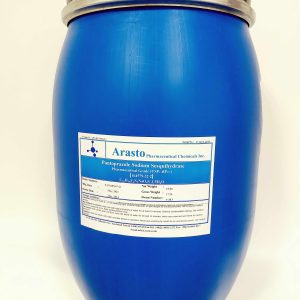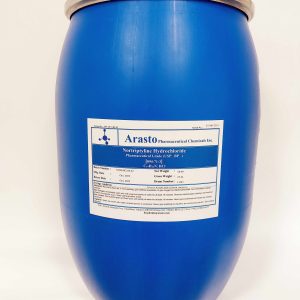Description
Description
(USP 44)
- Drug Substance General Information (ICH 3.2.S.1)
1.1. Nomenclature (ICH 3.2.S.1.1)
International non-proprietary name: Lamotrigine (Brand Name: Lamictl)
Compendial name: Lamotrigine
Chemical name: 1,2,4-Triazine-3,5-diamine, 6-(2,3-dichlorophenyl); 3,5-Diamino-6-(2,3-dichlorophenyl)-as-triazine.
Arasto’s code: LAM
CAS Registry Number: [84057-84-1].
- Drug Substance General Information (ICH 3.2.S.1)
1.2. Structure (ICH 3.2.S.1.2)

Empirical formula: C9H7Cl2N5
Molecular Weight: 256.09 g/mol
- Drug Substance General Information (ICH 3.2.S.1)
1.3. General Properties (ICH 3.2.S.1.3)
Lamotrigine is a white to off-white crystalline substance. It is administered orally for the treatment of partial seizures, primary generalized tonic-clonic seizures, generalized seizures of Lennox-Gastaut syndrome as well bipolar I disorder to delay the time to occurrence of mood episodes (depression, mania, hypomania, mixed episodes). Lamotrigine is very slightly soluble in water (0.17 mg/ml at 25°C) and slightly soluble in methanol. It is soluble in hot DMSO. Lamotrigine has a pKa if 5.7 (http://www.healthyplace.com/other-info/psychiatric-medications /lamotrigine- lamictal-full-prescribing-information/) and log P of 1.19 at pH 7.6 (R.H. Levy, R.H. Matts, B.S. Meldrum, E. Perruca, Antiepilectic Drugs, 2002, Lippincott Williams & Wilkins, USA, p 371). Lamotrigine is stable in acid but undergoes degradation under highly basic conditions (see Stability Studies). LD50 for Lamotrigine is 250 mg/kg oral in rat (http://www.drugbank.ca/drugs/DB00555).
The determination of purity and assay of APIs require comparison of the product with their respective Reference Standards (RS) and Related Compounds (RC or known impurities). Accordingly, ICH regulations on the purity and assay of reference standard and related compounds are clearly defined and must be followed by drug substance and drug product manufacturers.
According to ICH Q7, 11.1 there are 3 types of standards. This is summarized in the following chart and discussed in detail below.

The impurities provided in the following table represent Secondary Reference Standards (SRS) that are prepared in-house by synthesis or by isolation. Each SRS has undergone extensive characterization ( IR, UV, 1HNMR, 13CNMR. Mass Spec) and determination of its purity and assay (HPLC). For specification of the SRS of those products that have a monograph, the SRS is compared with a pharmacopoeia Primary Reference Standard (UV, HPLC retention time). For specification of those products that do not have a monograph (known as House Primary Standard), we compare their UV ε or ג /max , IR major absorptions, 1HNMR d (ppm) , 13 CNMR d (ppm) or HPLC retention time with values reported in the chemical literature for these compounds.

- Primary and Secondary Reference Standard (ICH 3.2.S.5)
5.1. Active Pharmaceutical Ingredient
Primary Reference Standard for lamotrigine is available from United States Pharmacopoeia. We will use a Secondary Reference Standard (previously referred to as Working Standard) for direct control of all batches of lamotrigine.
As per ICH (Q7, 11.1) and ICH (Q6, 2.11, 3.2, 3.3) the Secondary Reference Standards, which include the API and its Related Compounds, must be examined for their proof of structure (characterization), assay and purity and specification (identification by comparison). Furthermore, ICH Guideline on the Preparation of Common Technical Document (Q4M), requires that the data obtained from characterization, assay and purity and specification must be included in section 3.2.S.3.2 for Related Compounds (already discussed in that section) and section 3.2.S.5 of the DMF for the API. To this end, the Secondary Reference Standards of the API lamotrigine has undergone extensive characterization (UV, IR, 1 H NMR, 13C NMR, Mass Spec) to assure its structure, assay and purity (HPLC and/or titration) and specification (comparison of its HPLC retention time and UV ג /max with USP Primary Reference Standard).
The Secondary Reference Standard for lamotrigine was produced from a released batch by subjecting it to an additional crystallization from the final solvent system used in the production of the API to avoid the possibility of other polymorph formation.
SPECIFICATION OF ANALYSIS
| Product: Lamotrigine | CAS No.: 84057-84-1 | Spec. No.: APC-QC-SPEC-382-00 | ||
| Issue Date: Apr, 2023 | Valid up to: Apr, 2024 | Reference: USP44 | ||
| Tests | Specifications | |||
| Description | A white to pale cream-colored powder. | |||
| Solubility | Slightly soluble in 0.1N hydrochloric acid, in acetone, in methanol, and in water. | |||
| Identification | A: Infrared Spectroscopy B: The retention time of the major peak of the sample solution corresponds to that of the standard solution, as obtained in the assay. | |||
| Loss on drying | NMT 0.5% (at 105°C for 3 h) | |||
| Residue on ignition | NMT 0.1% | |||
| Residual Solvents | Methanol: NMT 3000 ppm (Class II) | |||
| Limit of Lamotrigine Related Compound B (HPLC) | NMT 0.1 % | |||
| Organic Impurities (HPLC) | Lamotrigine related Compound C: NMT 0.1% Lamotrigine related Compound D: NMT 0.2% Any individual unspecified impurity: NMT 0.1% Total impurities, excluding Related Compound B: NMT 0.2% | |||
| Assay (HPLC) | 98.0% to 102.0% (on the dried basis) | |||
| Prepared by: M. Shahbazi, B.Sc.Chem. | Checked by: A. Forghani, B.Sc.Chem. | |||
| Approved by: F. Javadizadeh, M.Sc.Chem. | ||||
| Storage: Preserve in tight containers. Store at room temperature. | ||||





